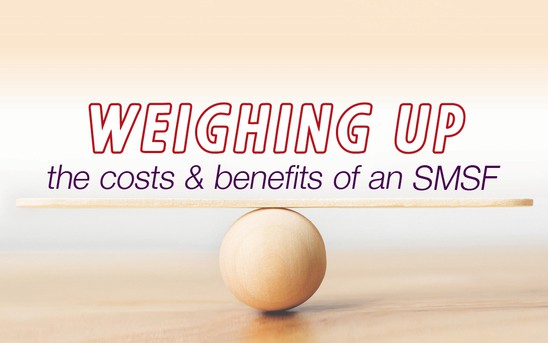
For many people, the idea of managing and investing your own retirement savings is very appealing.
But there is debate over whether running your own self-managed super fund (SMSF) is cost effective. So, what are the arguments for and against having your own fund?
Taking Control Of Your Super
People choose to run their own SMSF for many reasons. From a desire for flexible investment choices through to dissatisfaction with their existing super fund, tax and estate planning concerns.
According to a recent SMSF Association survey, many people’s desire for control over their personal retirement income goals and the ability to take control of their financial future are key motivators in the decision to run an SMSF.
For small business owners, the ability to invest in assets related to their business – such as their business premises – is also very appealing.
All these reasons are valid and may make it worth considering an SMSF for your retirement savings.
Benefits Of Your Own Super Fund
Key benefits are having control over your investment plan and selection of the assets in which your retirement savings are invested.
As an SMSF trustee, you are responsible for developing your fund’s investment strategy, so you get to choose which investment approach to use to grow your money.
Depending on your circumstances, there may also be cost savings compared to using a traditional, large super fund. An SMSF can also give you more flexibility when it comes to tax management, estate planning and how you pass on your wealth to your family.
SMSFs Can Be A lot Of Work
On the other hand, running an SMSF can require significant amounts of time to complete and lodge the necessary paperwork and to meet the strict compliance requirements for super funds.
We can help take a lot of the hard work out of running an SMSF for you and ensure you comply with all the rules. Failing to comply can result in significant penalties.
Although many people enjoy being accountable for their own retirement and tailoring their investments, achieving strong returns requires investment knowledge and skills, plus sufficient time to actively research and manage your investments.
In the case of fraud, SMSFs are treated differently to other funds and you have no access to the normal compensation arrangements. Also, there is no complaints body you can access to resolve disputes in a low-cost way. Your only recourse is the legal system.
It’s also worth keeping in mind the ATO is the main regulator for SMSFs, so you will have the tax man looking over your shoulder at all times.
Are SMSFs Competitive With Big Funds?
There is no hard and fast rule about the amount of super you need in order for your SMSF to be cost competitive with a large public super fund. Generally, an SMSF is less cost effective if your fund has low member balances.
It also costs more to run an SMSF if you choose to outsource most of the administrative tasks to service providers. These costs can eat into the higher investment returns you may achieve.
Smaller balance SMSFs are also less able to achieve sufficient diversification with their assets compared with larger funds, making it harder to spread your investment risk.
Aside from the establishment costs, running your own SMSF incurs annual costs such as the annual ATO supervisory levy, auditing and legal fees and any investment-related expenses.
SMSFs Can Be Cheaper
All this doesn’t necessarily mean running your own SMSF is a bad idea. In fact, it can be cheaper than using an APRA-regulated super fund to save for retirement.
The SMSF Association’s Cost of Operating SMSFs 2020 report found an SMSF can be cost-competitive with industry and retail super funds when it has an asset balance of $200,000 or more, even for a fund paying for a full administration service. An SMSF with accumulation accounts and a total asset balance of $200,000 using this type of service generally has annual running costs ranging from $1,518 to $3,078.
SMSFs are even more attractive for large asset balances. In fact, the study found an SMSF with a total asset balance of $500,000 or more is generally the cheapest alternative when it comes to a super fund. ASIC’s guidance also points to this.
For people interested in running their own SMSF but with a balance of only $100,000 to $200,000, you will need to keep an eye on your administration costs and consider what you may be able to manage yourself.
SMSFs with less than $100,000 are not cost-competitive. In our experience the better tripping point is $500,000 as well as your willingness to keep up with the administration and responsibilities as trustee.
Did You Know? 10 Interesting Facts About SMSFs
- $764 billion in super assets are held by SMSFs, which is one quarter of the total
- SMSF assets increased 29% from June 2015 to June 2020
- 593,790 SMSFs are regulated by the ATO
- 1.1 million member accounts are held in SMSFs
- $637,000 is the average member account balance in an SMSF
- Around half of all SMSF trustees own or have owned a small business
- 9 out of 10 trustees believe managing and engaging with their own SMSF provides them with a level of satisfaction
- Most SMSF trustees spend between 1 to 5 hours a month administering their fund
- Over 50% of SMSF members have had their SMSF for over 10 years
- 35 to 44 is the most common age range for establishing an SMSF
Both our financial planning and accounting divisions can assist you with establishing, maintaining and the compliance elements of your SMSF.
If you are interested in controlling your retirement savings, make an appointment to talk to us about whether an SMSF is right for you and how we can assist on 02 9299 2292 or myadviser@moneyclip.com.au.